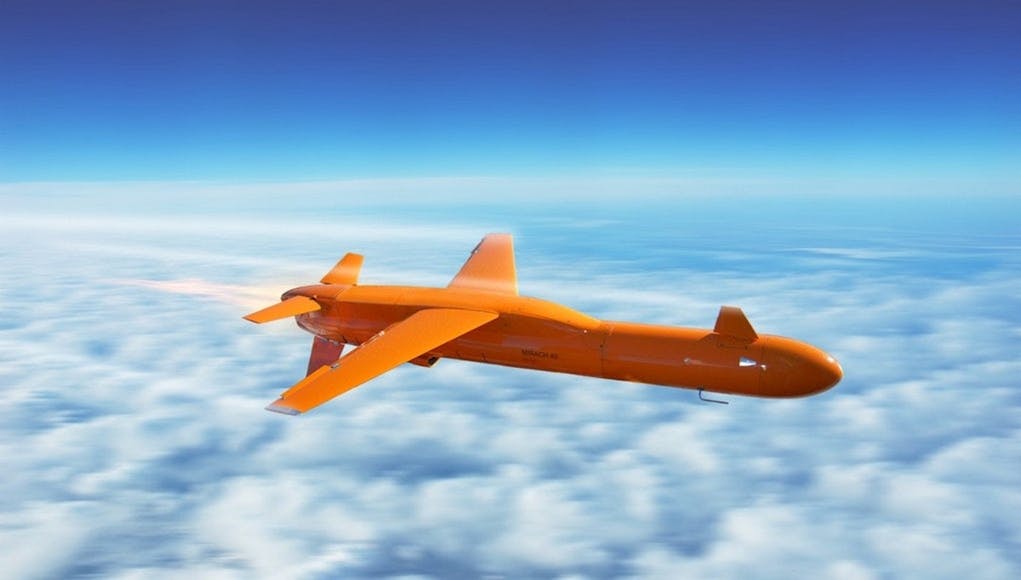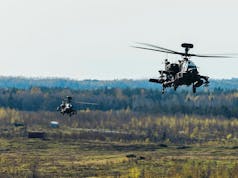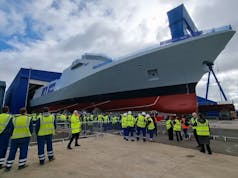Leonardo’s new M-40 target drone flew its first live missions for the Italian Navy in a recent training exercise at an Italian joint armed forces test range.
The exercise saw the aircraft carrier Cavour and its complement of AV8B+ fighter aircraft training alongside the destroyer Mimbelli against M-40 drones which were simulating a range of incoming threats.
The M-40 is an unmanned air vehicle which is able to convincingly mimic a variety of aircraft and missiles. It provides medium-to-high performance at a price comparable with competitors’ entry-level drones.
During the exercise, the M-40 played the part of a missile to simulate an attack against the Italian naval vessels and separately acted as a hostile enemy fighter in air-to-air combat scenarios.
During these missions, the Italian Navy personnel were able to ‘shoot down’ the reusable M-40 in realistic scenarios, allowing them to train with weapon systems including Aspide missiles.
The company say that this exercise was the first set of missions to make use of the M-40, which is able to represent a full spectrum of radar, infrared (IR) and visual threats. Because of its lower operating costs, the M-40 was able to provide the same level of training as previous exercises at a significantly reduced cost.














Does Aberporth still use something like this?
The ranges are run by Qinetiq and they use a number of drones such as the Banshee and Rattler, it mostly depends on the requirement. Check the following site, I believe Qinetiq bought out Meggit target systems, who provided the aerial targets:
http://targetsystems.qinetiq.com
Yes, still MoD but under the LTPA. Wasn’t sure of the drones.
I remember the Jindavicks at Llanbedr.
just came from another thread ranting about privatisation, heres another privatised government service, poor old RAE and ARE!
Although Qinetiq are doing good!
Both became the DERA in the interim.
The MoD has supposedly retained most of the classified juicy stuff in the DSTL but it still galls me when I see the MOD paying Qinetiq considering MoD once owned it.
I always find it funny when they say we have the very best classified stuff thats much better shape than the public stuff i.e. the armed services, we are told MI6 is massive and the best yet we have no proof it could just be a few blokes in the south bank building on a Sinclair C5! and a couple of agents in the field!
I highly doubt that though and Im sure MI5/6/GCHQ are the finest and more than enough for what Britain needs but well never know truly!
Keith
The UK’s Intelligence services , the SS, SIS, and GCHQ are amongst the worlds best. We are part of the UKUSA Sigint Alliance and 5 Eyes.
The SIS is not massive but with our colonial past it has extensive links, especially in the Middle East which the cousins across the pond lack.
In the Cold War the GCHQ’s area of expertise also encompassed the Middle East, and still does.
Could this be a potential basis for gavins swarm drone concept?
Interesting link to some potential concepts for it!
http://thedrive.com/the-war-zone/26467/u-k-s-sudden-move-to-field-a-drone-swarm-squadron-may-point-to-bigger-unmanned-developments
No, but this might.
http://thedrive.com/the-war-zone/26656/boeing-will-unveil-this-loyal-wingman-combat-drone-for-australias-air-force-tomorrow
Designed and built in Australia, we’d be happy to export some to the UK.
And there was me thinking we were getting ourselves in front of everyone, turns out we are behind and trying to catch up!
Well it’s a Boeing design so it’s not designed ‘to team’ with a Lockheed Martin F36 fighter. Also as it’s not stealth it would be a lousy wingman as it would give away the presence of the stealth F35.
Finally we need UCAVs/drones with VSTOL for use from the carriers.
So if the same announcement had been made in the UK no doubt you’d be trumpeting it as a great British breakthrough and innovation?
Read the article and check the pics.
It is both a stealthy design and intended to team with the F35. In fact the F35 its best placed to exploit a wingman concept having been designed by Lockheed Martin for this from the outset and having the computing power to make it work.
Drawing in Boeing’s expertise and following on from their win in the competition to build a tanker drone for the USN, the Australian drone will have fighter like speed, stealth and agility.
Why would Boeing limit the potential for global sales by building it to operate only with other Boeing aircraft?
It is Boeing’s biggest single investment in product development outside of the US, designed by Boeing’s engineers in Brisbane, built in Australia and destined for global exports.
Given the RAAF and the Australian government’s direct investment, you can guarantee they will appear in the RAAF’s inventory operating alongside their F35As.
With prototype development already advanced and first flight in 2020 it’s likely to be soon.
Welcome to the future of air warfare.
Just t clear up any doubts about the intention for the Boeing drone to work with the F35 see this article:
https://breakingdefense.com/2019/02/the-future-is-now-the-raaf-and-boeing-australia-build-an-f-35-unmanned-wingman/
Even mentions the potential to team with RAF’s Tempest concept (also not a Boeing design).
Boeings take on this is very interesting and why it’s interest in taking part in Tempest is worth examining. In the US it has serious restrictions as it says in the official launch plus of course it is not the favoured fighter developer in the US no matter how many programmes it is initially allowed to bid for.
“Faction” ?
Yes, which faction of what?
action
Quite surprised nobody has said ‘the RAF needs 4 sqns of these’ it’s a disgrace we don’t! . ?
The missile threat faced by NATO navies has dramatically evolved to include saturation attacks of supersonic anti-ship missiles that are highly agile in their terminal phase. I hope those threats are being simulated and successfully countered in practice environments. Otherwise, we risk lulling ourselves into a false sense of security.
Absolutely agree with the need to exercise against supersonic targets
Unfortunately the Leonardo drone is subsonic and with a max speed of 720 kmh is slower (but more agile) than some commercial airliners
The RAN’s Anzac frigates with their CEAFAR phased array radars have proven their capacity to intercept multiple QGM 164 Coyote missiles traveling st between Mach 3 and Mach 4
For the Royal Navy’s sake you would want to hope they have a similarly proven capability with actual supersonic targets otherwise their ships will be extremely vulnerable in the SCS
I believe Sampson can track hundreds of supersonic targets as small as a cricket ball out to something like 200 miles. The question will be whether these current radars can handle hypersonic threats travelling at Mach 7 plus, as we are only a few years away from countries such as Russia fielding them. I’m genuinely concerned how far behind we seem to be in this field, and see a lack a urgency to both develop our own equivilients and means to counter them. Within a decade our ships could be targeted with hypersonic that have ranges of a 1000 miles, whilst we will have harpoon, thus risk being picked off without ever getting near to the fight. And will Seaceptor be able to defend against a Mach 9 asm?
Will be interesting to see if the rotating radar array on the Sampson ultimately becomes its Achilles heel (compared to fixed flat panel AESA arrays) against high Mach (7+) targets?
Despite its ultra rapid rotation rate the laws of physics of physics must kick in at some point. Would be interesting to hear the views of some of the radar tech experts on here.
A point to consider between fixed panel AESA (SPY-2) and rotating AESA such as Sampson is the radar horizon. Clearly by placing the radar at the highest point of the ship extends the radar horizon over say a panel placed lower down on the structure. However, this places a limitation on the size of the antenna array due to the weight. A balance will need to be struck between the size, height and weight of the array the ship can handle when placed that high. This can limit the effective radiated power that the radar can transmit, which depending on the frequency will affect the radar’s range. The maxim of the larger the antenna the more power and therefore the greater achievable range still holds true. This is particularly true of the older style pulse-doppler radars which had limited signal processing. Today, the signal processing goes hand in hand with the radar’s effective power and can effectively double the effective resolution range of a radar due the advanced filtering and processing algorithms, i.e. what was once seen as noise or very weak returns can now be interrogated for targets etc.
The other issue between flat panels and a rotating panel, is that you can transmit and receive out of all four panels concurrently, however, at a reduced power level. This is due to the amount of current these high power radars use, so unless the ship has excess power generation, this can constrain the amount of power or the number of panels you use at any one time. Conversely a rotating panel can transmit at maximum power at all times (so long as it has sufficient cooling).
So both systems have their advantages and disadvantages. The AESA method of controlling the transmitted beam with its very high sweep rate mitigates to a degree the refresh rate. This coupled with the high rotation rate <2 sec will allow the radar to search for a mach 4+ (4939.2kph @20C at Sea level) missile. However, tracking a missile as it closes with the ship will require range gate techniques at these speeds which record and predict the track of the missile, whereas the fixed panel will have the advantage as it can apply continuous illumination, once its within the radar horizon. This is one of the reasons Sampson has two antenna arrays placed back to back, thus reducing the dead zones, it won't totally eliminate them, hence the very high spin rate.
Understand (at a layman’s level) the trade-offs inherent in both approaches as they are currently fielded.
But in a (not too distant) future world with a proliferation of hypersonic (technically Mach 5 but for sake of the scenario let’s say Mach 7+) weapons systems and saturation attacks with multiple missiles which system should navies back for future development?
Will the ultimate future radar system in this scenario be a rotating AESA radar (i.e. a Sampson style design) or will faster missiles mean rotating systems will approach design limits (top weight or rotation speeds)?
Or will flat panel systems overcome their limitations through increases in onboard ship power or increased computer processing systems to take advantage of their larger arrays?
Which system is better if incoming missiles or aircraft are themselves using range gating pull off to spoof the radars?
Which one would you bet your house (or navy) on??
That’s the conundrum?
Any AESA panel array has a field of view of 120 degrees in the E and H planes. So for a rotating antenna with two arrays place back to back means there are two 60 degree dead zones perpendicular to the antenna ends. The four fixed panels do not have these dead zones. It is possible for the field of view to go past 120 degrees but range and resolution suffer. This is one of the reasons Typhoon CAPTOR-E has a mechanical antenna repositioner, so its field of view is increased – major advantage.
If we can in the future have four AESA panels that can be used concurrently and at full power indefinitely and still allow the ship to fight, the fixed panelled array has the advantage. However, due to its physical size and weight, it is limited on where it can be placed on the ship. Moore’s law states that in every two years the number of transistors placed in a dense integrated circuit doubles. Therefore signal processing and noise filtering will keep improving, making it easier to detect stealthy targets amongst clutter and at a greater distance. However, if we are using realistic frequencies, so D band (1GHz) and above, then the radar horizon is still pretty much determined by the visible horizon set by the radar’s height above sea level. The rotating AESA panel will still have the advantage of first detecting the threat as it will be a the highest point of the ship, but this will only give an increased threat warning of a few seconds, perhaps enough to cue the automated defences for a missile travelling at the proposed mach 7+ speeds.
The answer I believe is two fold. For a ship operating as part of a task group, then Airborne Early Warning (AEW) from Crowsnest is the obvious answer, which has its radar data networked with the air defence ships T45/26. This is the current option for long distance early detection and will allow Aster 30 the maximum time/range for engagement. The second option would be for ships operating on their own. This is with some form of tethered air vehicle. The reason for tethering is to ensure the airborne radar has plenty of power, but also when operating as a electronic support measures (ESM) platform i.e. going silent and just listening, it won’t be detected.
The problem comes from the type of aircraft that could do this, as it needs to have the capability of flying 24/7. In Afghan we used aerostats that flew next to airfields/bases at a height of 2500ft. They had electro-optic turrets that could see in the visual and infra-red spectrum to monitor the surrounding area. But they were unwieldy and couldn’t fly in high winds, which isn’t much use for a ship. The other option would be a unmanned gyro-copter, but again although more wind resistant than the blimp it is still weather dependent. There is another possibility, using unmanned surface vessels acting as pickets for the mother-ship. Fitted with a 3D radar that has its data transmitted back to the ship via narrow beam transmission. With at least three of these vessel operating around the mother-ship would significantly extend the radar horizon. It could also be used for monitoring activities under the surface as well.
So for the present, there are a number of options for a ship today operating on its own. One is to have a rotating AESA panel doing the horizon search and four AESA panels attached to the sides doing the tracking. This will require a significant increase in the ships’s electrical production e.g. a combination of Samspon and CEAFAR radars. Another thought would be perhaps two Sampsons operating at 90 degrees synchronisation to each other thus each panel can cover a 90 degree sector. This would give the increased radar horizon, but also significantly reduce the refresh rate and dead zones. Again this will need a lot of extra power production and I’m not sure even with the new engines a T45 is getting would be enough to cope.
Just a thought!
I do wonder if the threat of Hypersonic missiles is being overplayed. These missiles will be relatively small to ensure they can manage the speed and associated stress of very high g force manourvering, hence war head size will also be limited, likewise the amount of internal guidence equipment is small. Therefore to hit a manourvering target will be quite a feat. A missile moving at mach 5 + must have a final target solution plotted at a substantial distance from the ship thus buying critical evasion space. Just a thought.